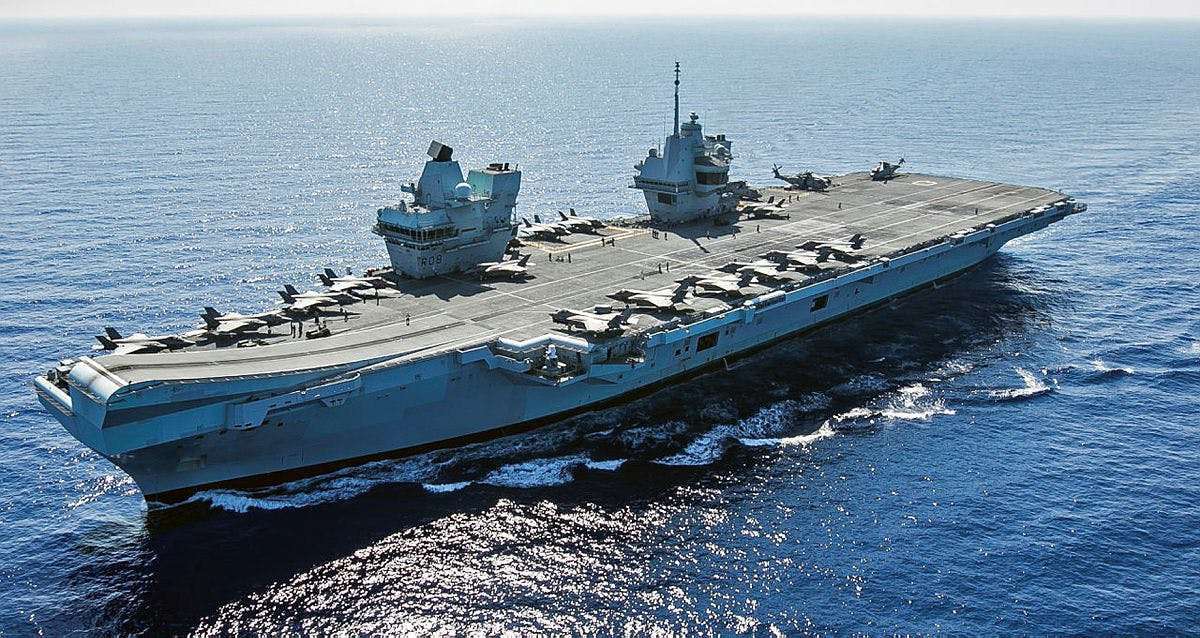Aircraft carrier HMS Queen Elizabeth and her Carrier Strike Group have entered the South China Sea for the second time, despite Chinese warnings.
This is the second time the British carrier strike group has entered the disputed region.
UK Carrier Strike Group 21 is entering the South China Sea through Bashi Channel. pic.twitter.com/Gz6EKrpDov — Duan Dang (@duandang) October 4, 2021
China previously issued a warning to the UK’s Carrier Strike Group not to carry out any “improper acts” as it entered the South China Sea for the first time earlier this year. The pro-government Global Times, which is seen as a mouthpiece for the ruling Chinese Communist Party, said:
“The People’s Liberation Army Navy is at a high state of combat readiness China has been closely monitoring the progress of the Carrier Strike Group, which is currently sailing through the South China Sea en route to Japan. It has also accused Britain of “still living in its colonial days.”
China claims almost all of the 1.3 million-square-mile South China Sea as its sovereign territory, and it has denounced the presence of foreign warships there as the root of tensions in the region.
China say that its claim to the sea is based both on the Law of the Sea Convention and its so-called ‘nine-dash’ line. This line extends for 2,000 kilometers from the Chinese mainland, encompassing over half of the sea. However in an historic decision in 2016, the international tribunal in The Hague ruled against part of China’s claims to the sea.
The US, UK and Australia routinely conduct freedom of navigation operations (or FONOPs) to challenge what Washington calls “attempts by coastal states to unlawfully restrict access to the seas”.
Both the US and UK have angered China previously by carrying out ‘Freedom of Navigation Patrols’ in the South China Sea to assert rights to freedom of navigation. For more on why the Carrier Group is in the disputed region, follow the link below.
Chinese defence spokesman Tan Kefei was quoted in the South China Morning Post as saying:
“The Chinese side believes that the South China Sea should not become a sea of great power rivalry dominated by weapons and warships. The real source of militarisation in the South China Sea comes from countries outside this region sending their warships thousands of kilometres from home to flex muscles. The Chinese military will take necessary measures to safeguard its sovereignty, security and development interest as well as peace and stability in the South China Sea.”
Back at the start of the month, Foreign Secretary Dominic Raab told MPs that “It’s absolutely right we exercise and defend the rights, and we do so from the Ukrainian territorial sea to the South China Sea” after discussions on a British warship sailing through Ukrainian territory claimed by Russia.
What happened last time a British vessel sailed through the South China Sea?
In 2018, assault ship HMS Albion was challenged by a Chinese frigate and two helicopters during freedom of navigation exercise in the South China Sea. Local media report that both sides remained calm during the encounter and the Royal Navy assault ship continued on course despite protests from China.
What is the UK Carrier Strike Group doing?
HMS Queen Elizabeth is the deployed flag ship for Carrier Strike Group 21 (CSG21), a deployment that will see the ship and her escorts sail to the Asia-Pacific and back. The Carrier Strike Group includes ships from the United States Navy, the Dutch Navy, and Marines from the US Marine Corps as well as air assets from 617 Sqn, 820 NAS, 815 NAS and 845 NAS.
The Royal Navy say that the UK’s Carrier Strike Group will visit more than one fifth of the world’s nations. Led by HMS Queen Elizabeth, the task group will visit 40 nations including India, Japan, Republic of Korea and Singapore in a deployment covering 26,000 nautical miles.
“While in the Pacific, ships from the Carrier Strike Group will mark the 50th anniversary of the Five Powers Defence Agreement between Malaysia, Singapore, Australia, New Zealand and the UK by taking part in Exercise Bersama Lima. Joining HMS Queen Elizabeth on her maiden deployment are destroyers HMS Diamond and Defender; frigates HMS Richmond and Kent; an Astute-class submarine in support below the waves; and Royal Fleet Auxiliary support ships RFA Fort Victoria and RFA Tidespring.
More than 30 aircraft will also embark across the task group including F-35 jets from 617 Squadron, the Dambusters, and the US Marine Corps’ VMFA-211; Wildcat helicopters from 815 Naval Air Squadron and Merlin helicopters from 820 and 845 Naval Air Squadrons. Royal Marines from 42 Commando will also deploy with the carrier. Dutch frigate HNLMS Evertsen and American Arleigh Burke destroyer USS The Sullivans are also part of the strike group.”
For analysis on the rationale behind entering the South China Sea, followthe link below.

zous on October 4th, 2021 at 16:36 UTC »
Isn't this normal and a way for the international community to say "you can't just claim international waters"?
palordrolap on October 4th, 2021 at 14:01 UTC »
"Your warnings won't stop me. I can't read Chinese."
_snowdon on October 4th, 2021 at 12:55 UTC »
"Britain sails in international waters"